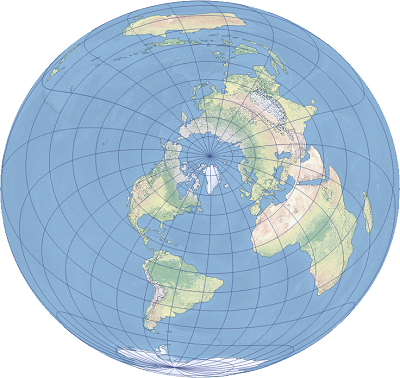Description
The two-point equidistant projection is a modified azimuthal projection that preserves distances from two selected points on the map. If the two points are the same, the resulting projection is the azimuthal equidistant projection.
The projection was first presented by Hans Maurer in 1919. Two year later, Charles F. Close independently presented it in 1921. It is available in ArcGIS Pro 1.0 and later and in ArcGIS Desktop 8.0 and later.

Projection properties
The subsections below describe the two-point equidistant projection properties.
Graticule
The two-point equidistant projection is a modified azimuthal projection. All the meridians and parallels project as complex curves. The poles are normally points within the map. The graticule is bounded by an ellipse, where the two focal points are on a semimajor axis and its eccentricity grows as the defining points are farther apart. There generally is no symmetry of the graticule unless the line connecting the two defining points lies on a meridian or the equator.
Distortion
The two-point equidistant projection is neither conformal nor equal-area. Shapes, areas, distances, directions, and angles are all generally distorted. All distances are true from the two chosen points to any other point on the map. A straight line from either point represents the correct great circle length but not the correct great circle path.
Usage
The two-point equidistant projection was used by the National Geographic Society for maps of Asia. It is appropriate for specific map applications to show relationship between two known locations on the map, such as a ship's or airplane's distance from the start and end of its voyage.
Limitations
The two-point equidistant projection is supported on spheres only. For an ellipsoid, the semimajor axis is used for the radius. Some equidistant properties might not be maintained when an ellipsoid is used.
Parameters
Two-point equidistant projection parameters are as follows:
- False Easting
- False Northing
- Latitude of 1st point
- Latitude of 2nd point
- Longitude of 1st point
- Longitude of 2nd point
Particular parameter cases
When the two points are identical, the resulting projection is the azimuthal equidistant projection.
Sources
Snyder, J. P. (1993). Flattening the Earth. Two Thousand Years of Map Projections. Chicago and London: University of Chicago Press.
Snyder, J. P. and Voxland, P. M. (1989). An Album of Map Projections. U.S. Geological Survey Professional Paper 1453. Washington, DC: United States Government Printing Office.
Thomas, P. D. (1970). Spheroidal Geodesics, Reference Systems, & Local Geometry. Washington, DC: United States Naval Oceanographic Office.